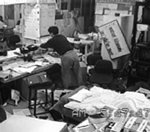|
From reactive to proactive
NHK is the only official news organ responsible
for providing disaster information under the Disaster Measures Basic
Law. In particular, NHK must always be ready to respond without delay
in the case of a major earthquake.
When the Great Hanshin-Awaji Earthquake
struck on January 17, 1995, NHK's Kobe Station was equipped with a "skip-back
recorder," a device that automatically records video footage from
the moment the earth begins shaking. The quake was the most intense
ever captured on film or video anywhere. Even though power was cut only
moments after the quake began, the skip-back recorder was able to keep
rolling from beginning to end because it was equipped with a special
battery.
After the earthquake, NHK was deluged with
calls from people trying to find out if relatives and friends were safe,
and the Osaka Station used the NHK Educational TV and FM Radio channels
to broadcast this information for nearly 160 hours.
It is standard procedure for NHK to interrupt
other programming to provide special reports when a disaster occurs.
Disaster information was once "reactive," just a report of
the consequences after the damage had been done, but recently the focus
has changed to "proactive" advance warnings that help viewers
to be prepared. Typhoon information is a good example of this change.
The TV screen displays cloud and radar images from weather satellites,
followed by graphics showing predictions of rainfall at numerous locations.
On top of this, NHK robot cameras set up all around Japan can now provide
real-time pictures of strong winds and torrential rain. Pictures from
another set of robot cameras maintained by the Ministry of Land, Infrastructure
and Transportation along major rivers can also be fed into broadcasts.
Experts have noted that the number of typhoon
casualties has declined in recent years. The next challenge is to improve
earthquake-related coverage. Compared to typhoons, which can be predicted
somewhat beforehand, the terror of earthquakes is that they strike without
warning.
NHK will continue to provide disaster information
even more effectively using the superlative high-resolution images of
Hi-Vision (HDTV).
|
|
|

Election reporting: a change in
the 90's
In Japan, exit polls for use in election reporting began in the
1990's. Starting with the elections for the Lower House of the
Japanese Diet in the summer of 1993, NHK introduced exit polls
based on statistical methods used in the U.S. and Europe. These
transformed the nature of election reporting in Japan. In the
Upper House election of 1998, then-Prime Minister Hashimoto's
declaration that he would resign—when ballot-counting had only
just begun—was strongly influenced by the exit poll results released
on all TV channels immediately after the close of voting. He already
knew from the TV coverage that his party had suffered a crushing
defeat. In recent elections it has become difficult, even using
public opinion surveys, to evaluate election prospects in advance,
so the responses of voters at exit polls are often the first time
that the strengths and weaknesses of the candidates and momentum
of the popular vote become clear. It is now an accepted fact that
exit poll results announced right after voting ends set the political
world back in motion.
The next change in election reporting may come from electronic
voting. In June 2002, Niimi City in Okayama Prefecture used electronic
voting for its mayoral and city council elections. There are many
matters still to be resolved, and e-voting isn't poised to sweep
the nation just yet. But assuming that cost and reliability issues
can be overcome, it will offer a quick and reliable way to count
ballots automatically.
|
|
 Skip-back
recorder Skip-back
recorder
Engineers at the Kobe Station had anticipated a scenario in which
the power company would be unable to supply electricity and the
station's own auxiliary generators would also fail. They equipped
their skip-back recorder with a small uninterruptible power supply.
That was why the moment of the earthquake was caught on video.
|
230 employees on standby / Digital disaster
reporting
|



